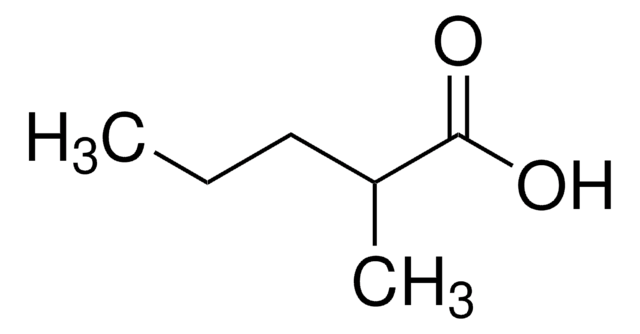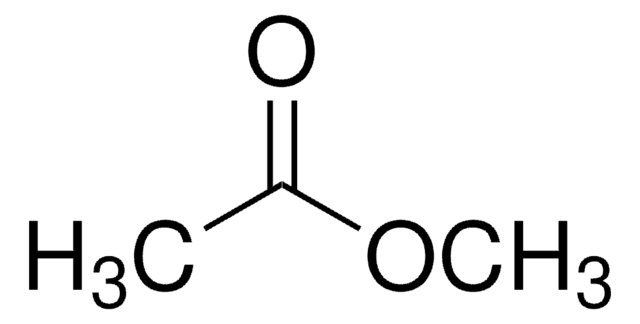Wichtige Dokumente
W270806
Capronsäure-methylester
≥99%, FG
Synonym(e):
Capronsäuremethylester, Methylhexanoat
About This Item
Empfohlene Produkte
Biologische Quelle
synthetic
Qualitätsniveau
Qualität
FG
Fragrance grade
Halal
Agentur
(EU Regulation 1223/2009)
(follows IFRA guidelines)
meets purity specifications of JECFA
Einhaltung gesetzlicher Vorschriften
EU Regulation 1334/2008 & 178/2002
FDA 21 CFR 172.515
Assay
≥99%
Brechungsindex
n20/D 1.405 (lit.)
bp
151 °C (lit.)
mp (Schmelzpunkt)
−71 °C (lit.)
Dichte
0.885 g/mL at 25 °C (lit.)
Anwendung(en)
flavors and fragrances
Dokumentation
see Safety & Documentation for available documents
Nahrungsmittelallergen
no known allergens
Allergener Duftstoff
no known allergens
Organoleptisch
fruity; ethereal; pineapple
SMILES String
CCCCCC(=O)OC
InChI
1S/C7H14O2/c1-3-4-5-6-7(8)9-2/h3-6H2,1-2H3
InChIKey
NUKZAGXMHTUAFE-UHFFFAOYSA-N
Suchen Sie nach ähnlichen Produkten? Aufrufen Leitfaden zum Produktvergleich
Verwandte Kategorien
Anwendung
- Effect of fat nature and aroma compound hydrophobicity on flavor release from complex food emulsions.: This study investigates how the nature of fat and the hydrophobicity of aroma compounds, including Methyl hexanoate, influence flavor release in complex food emulsions. The findings provide insights into the interactions between fat types and aroma compounds, which can help in the formulation of food products with optimized flavor profiles. (Relkin et al., 2004).
Signalwort
Warning
H-Sätze
P-Sätze
Gefahreneinstufungen
Flam. Liq. 3
Lagerklassenschlüssel
3 - Flammable liquids
WGK
WGK 3
Flammpunkt (°F)
99.5 °F - closed cup
Flammpunkt (°C)
37.5 °C - closed cup
Persönliche Schutzausrüstung
Eyeshields, Faceshields, Gloves, type ABEK (EN14387) respirator filter
Hier finden Sie alle aktuellen Versionen:
Besitzen Sie dieses Produkt bereits?
In der Dokumentenbibliothek finden Sie die Dokumentation zu den Produkten, die Sie kürzlich erworben haben.
Kunden haben sich ebenfalls angesehen
Global Trade Item Number
| SKU | GTIN |
|---|---|
| W270806-20KG | 4061838180933 |
| W270806-1KG | 4061838257239 |
| W270806-4KG | 4061838257246 |
| W270806-9KG | |
| W270806-SAMPLE | 4061838192059 |
Unser Team von Wissenschaftlern verfügt über Erfahrung in allen Forschungsbereichen einschließlich Life Science, Materialwissenschaften, chemischer Synthese, Chromatographie, Analytik und vielen mehr..
Setzen Sie sich mit dem technischen Dienst in Verbindung.












